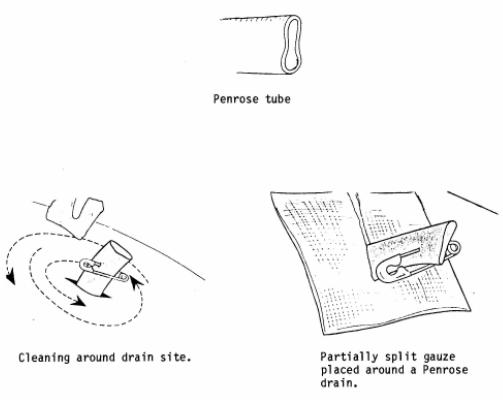|
Lesson 4: Postoperative Care of the Surgical Patient
Section III. EFFECTS OF SURGERY ON THE INTEGUMENTARY SYSTEM
When wounds occur, a variety of effects may result, such as immediate loss of all or part of organ functioning, sympathetic stress response, hemorrhage and blood clotting, bacterial contamination, and death of cells. Careful asepsis is the most important factor in keeping these effects to a minimum and promoting the successful care of wounds.
4-9. POSSIBLE NEGATIVE EFFECTS
a. Wound Infection. The first sign of wound infection is increased pain in the incision. The incision shows signs of infection by becoming reddened, warm, and swollen and by draining pus-like material. If a patient develops a wound infection, it is important to prevent it from spreading to other patients.
b. Wound Separations. This is the breaking apart of the edges of the incision. The causes of wound separation are malnutrition (which interferes with the normal healing process), defective suturing, infection, and excessive strain on the wound from retching, coughing, etc. Dehiscence and evisceration are two types of wound separations (see Figure 4-1).
-
(1) Dehiscence. This is the separation (opening) of the wound edges without the protrusion of organs. Small openings are not unusual and may be closed or supported with sterile tape. The openings always need to be supported and the wound observed regularly for further openings.
-
(2) Evisceration. This is the separation of the wound edges with the protrusion of organs. This rarely happens, but it is a serious complication when it does happen. The patient is usually taken to surgery immediately for resuturing.
One of the most fundamental and marvelous defensive properties of living organisms is the power to heal wounds. The reaction of tissues to a surgical incision differs only in degree from that caused by a laceration (usually occurring in accidents). There are always bacteria on the skin that are carried into deeper tissues, even when the wound is a surgical incision. Clean wound healing is an intricate, exact biological process. The two types of wound healing discussed in this subcourse are primary and secondary.
a. Primary. This is a form of connective tissue repair that involves the proliferation of fibroblasts and capillary buds and the subsequent laying down of collagen to produce a scar.
b. Secondary. This is healing of an open wound where there has been a significant loss of tissue. The defect must be filled by a slow buildup of new connective tissue. This process results in a large scar formation.
4-11. FACTORS WHICH MAY IMPAIR WOUND HEALING
The following factors may impair wound healing.
a. Inadequate nutrition.
b. Hypoproteinemia and vitamin C deficiency.
c. Anemia.
d. Diminished blood supply to the area.
e. Steroid administration (cortisone inhibits subsequent fibroplasia and collagen formation).
f. Obesity.
g. Diabetes mellitus.
h. Debilitating diseases, such as cancer.
i. Infection.
4-12. FACTS ABOUT WOUND DRAINS
a. The technique of using drains, tubes, and catheters at the wound site may be necessary to promote healing by permitting fluid to be removed from the surgical site. This technique is often used to drain abscesses and intestinal contents when leakage may occur.
b. The Penrose drain is the most common type of drainage system used. It is made of soft rubber and causes little tissue reaction. It is sutured to the skin and a safety pin is placed externally to maintain its position. The Penrose drain acts by drawing any pus or fluid along its surfaces through a stab wound adjacent to the main incision. See Figure 4-2 for a Penrose drain.
The Brookside Associates Medical Education Division is dedicated to the development and dissemination of medical information that may be useful to medical professionals and those in training to become medical professionals. This website is privately-held and not connected to any governmental agency. The views expressed here are those of the authors, and unless otherwise noted, do not necessarily reflect the views of the Brookside Associates, Ltd., any governmental or private organizations. All writings, discussions, and publications on this website are unclassified.
© 2007 Medical Education Division, Brookside Associates, Ltd. All rights reserved

